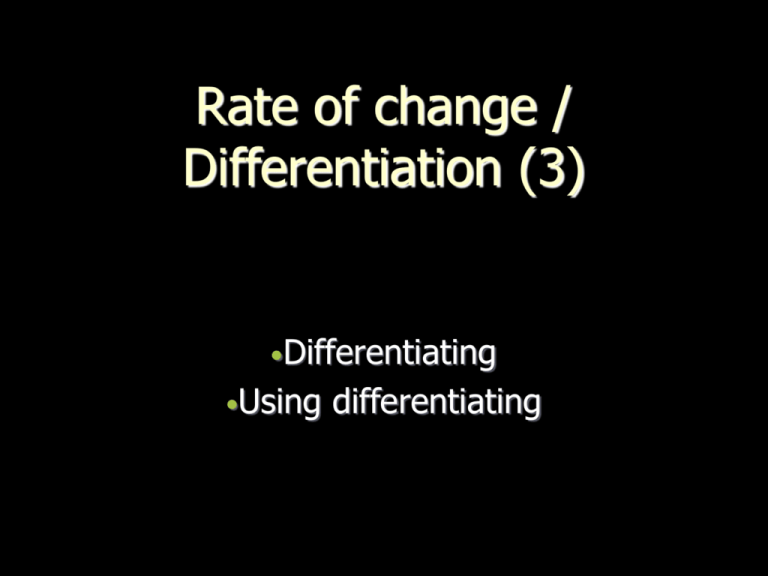y - Uplift Education
advertisement

Rate of change / Differentiation (3) •Differentiating •Using differentiating The Key Bit The general rule (very important) is :- n x If y = dy = nxn-1 dx E.g. if y = x2 dy = 2x dx E.g. if y = x3 dy = 3x2 dx E.g. if y = 5x4 dy = 5 x 4x3 dx dy 3 = 20x dx Warm-up Find dy for these functions :dx y= dy = 4x dx 2x2 y= 2x5 dy = 10x4 dx y= 5x2 dy = 10x + 10 dx y= x3 y= 2x4 + 10x + 5 + - x2 +x 4x2 +7 Gradient at x=-2 = -8 = 10x(-2)4=160 = -20 + 10 = -10 dy = 3x2 + 2x +1 = 3(-2)2+2(-2)+1 dx dy = 8x3 - 8x dx = 12 -4 +1 = 9 = 8(-2)3 -8(-2) = 8 x-8 – 8 x-2 = -64 +16 = -48 A differentiating Problem The gradient of y = ax3 + 4x2 – 12x is 2 when x=1 What is a? dy = 3ax2 + 8x -12 dx When x=1 dy dx = 3a + 8 – 12 = 2 3a - 4 = 2 3a = 6 a=2 Try this The gradient of y = 4x3 - ax2 + 10x is 6 when x=1 What is a? dy = 12x2 – 2ax + 10 dx When x=1 dy dx = 12 -2a +10 = 6 22 - 2a = 6 16 = 2a a=8 Rate of change / Differentiation (3 pt2) •Equations of tangents •Equations of normals Function Notation We have seen: if y = x3 – 12x dy = 3x2 - 12 dx Instead of ‘y’ we may use the function notation f(x) If then so f(x)= x3 – 12x dy dx is replace by f’(x) f’(x)= 3x2 - 12 f’(x) represent the differential/gradient function Linear graphs y mx c Gradient = Increase in y GradientIncrease in x dy dx y - intercept m and c will always be numbers in your examples y = 5x + 7 y = 2x - 1 Definition Parallel lines are ones with the same slope/gradient. i.e. the number in front of the ‘x’ is the same y = 3x - 11.31 y = 3x y = 3x + 8 y = 3x + 84 y = 3x - 21 y = 3x + 1 y = 3x - 1.5 y = 3x + 2/3 y = 3x - 3 y = 3x + 43 Equations of Tangents y=x2 The tangent to the curve is the gradient at that point y (3,9) x What is the equation of the tangent? y = mx + c y=x2 Substitute gradient: dy = 2x 9 = 6 x3 + c dx c = 9 - 18 = -9 dy When x=3; = 2 x3 = 6 y = 6x - 9 dx Equations of Tangents - try me y=3x2 + 4x + 1 y (1,8) x - differentiate gradient at x =1 y = mx + c find c What is the equation of the tangent? y = mx + c y=3x2 + 4x + 1 Substitute gradient: dy = 6x + 4 8 = 10x1 + c dx c = 8 - 10 = -2 dy When x=1; = 6+4 = 10 y = 10x - 2 dx Perpendicular Lines If two lines with gradients m1 and m2 are perpendicular, then: 1 m2 m1 m1m2 1 Equations of Normals y=x2 The normal is always perpendicular to the tangent y normal mT x mN = -1 (3,9) x What is the equation of the normal? dy y = mx + c When x=3; = 2x3 = 6 dx Substitute gradient: mT x mN = -1 9 = -1/6 x 3 + c 6 x mN = -1 c = 9 - -3/6 = 9 + 1/2 y = -1/6 x + 9 1/2 mN = -1/6 Equations of Normals y=x2 The normal is always perpendicular to the tangent y normal mT x mN = -1 (3,9) x What is the equation of the normal? dy y = mx + c When x=3; = 2x3 = 6 dx Substitute gradient: mT x mN = -1 9 = -1/6 x 3 + c 6 x mN = -1 c = 9 + 3/6 = 9 + 1/2 y = -1/6 x + 9 1/2 mN = -1/6 Equations of Normal - try me y=3x2 + 4x + 1 y (1,8) normal x - differentiate gradient at x =1 mt x mn = -1 y = mnx + c find c What is the equation of the normal? dy y = mnx + c = 6x + 4 dx Substitute gradient: dy When x=1; = 6+4 = 10 8 = -1/ x 1 + c dx 10 c = 8 + 1/10 = 8 1/10 mT x mN = -1 1/ 1/ y = x + 8 1 10 10 10 x mN = -1 mN = - /10







